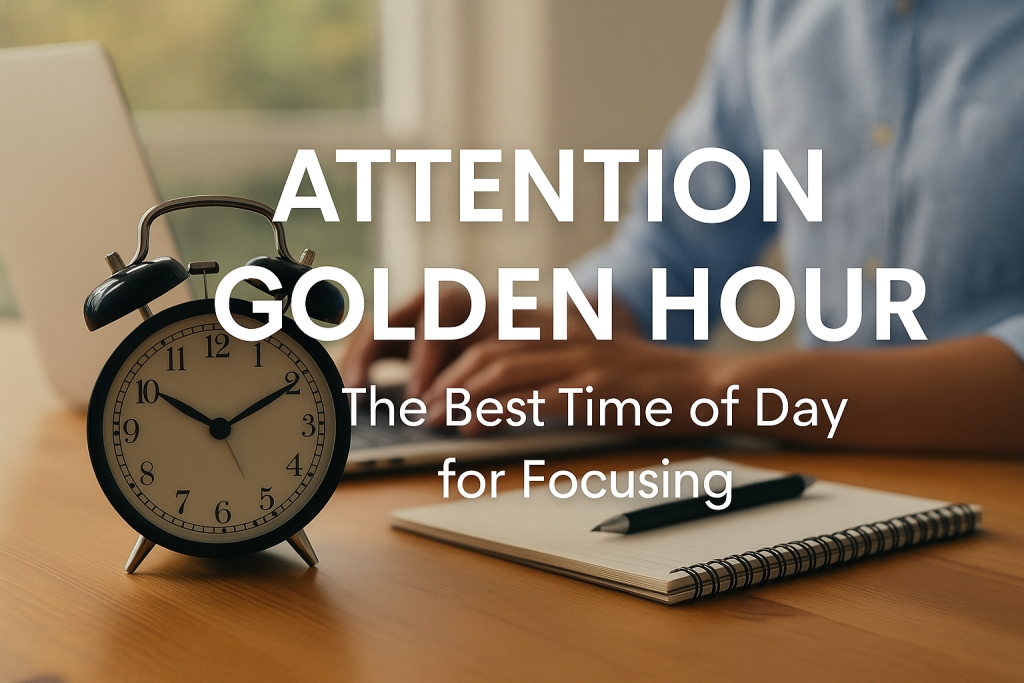Attention Golden Hour: The Best Time of Day for Focusing
Find your brain’s peak zone — and use it to do your best work
Struggling to Focus No Matter How Hard You Try?
You set aside time to concentrate, clear your workspace, silence your phone — and still, your mind wanders. Tasks that should take 20 minutes drag on for hours. The problem might not be your habits — it might be your timing.
Just like your body has energy cycles, your brain has attention cycles. There’s a window during the day when your mental clarity, focus, and productivity naturally peak — this is your attention golden hour.
In this article, we’ll explore the best time of day for focusing, why it varies for different people, and how to find and use your own golden hour for deeper, faster, and more fulfilling work.
—
The Science Behind Daily Focus Fluctuations
Your Brain Follows a Natural Rhythm
Our bodies run on a 24-hour circadian rhythm — the internal clock that governs sleep, energy, and cognitive performance. Within this rhythm, we experience natural peaks and dips in attention and alertness.
Trying to focus during a natural low point is like swimming against the current. But when you align work with your high-attention zone, everything flows easier.
Chronotypes: Not Everyone Peaks at 9 AM
People generally fall into one of three chronotypes:
- Morning types (larks): peak focus early in the day
- Evening types (owls): sharper attention later in the day or night
- In-between types (third birds): best in late morning or early afternoon
Knowing your chronotype helps you plan demanding tasks when your brain is most alert — not just when your calendar is free.
—
How to Identify Your Attention Golden Hour
1. Track Your Energy and Focus Levels
Spend a few days noting when you feel most clear-headed, alert, and mentally energized. Use a simple log or app to track:
- When do you get into flow state easily?
- When are you most easily distracted?
- When does your mind feel foggy or tired?
2. Watch Your Work Patterns
Notice when your best work gets done. Do you naturally gravitate toward focus in the early hours, or do you come alive after lunch or in the evening?
3. Experiment with Time Blocks
Try doing deep-focus work (like writing, coding, planning) at different times and compare output and energy levels. Within a few days, you’ll begin to spot your natural attention high points.
—
How to Maximize Your Golden Hour
Protect It Ruthlessly
Once you know your golden hour, guard it. Block the time in your calendar. Avoid meetings, email, or errands during this window. Let others know this is your “deep work” time.
Prepare Your Environment
Minimize friction: clean your workspace, turn off notifications, and prepare your tools. Set a clear intention before you begin so your brain knows what to focus on.
Use the Right Task for the Right Time
Don’t waste your golden hour on shallow work. Use it for your highest-priority task — the one that requires focus, creativity, or strategy. Save admin work or light tasks for your low-energy periods.
—
Bonus: What to Do During Low-Attention Times
Schedule Breaks and Recovery
Use dips in energy for walking, stretching, or taking mindful breaks. These aren’t wasted — they restore mental resources for your next focus session.
Handle Admin or Routine Tasks
Use lower-focus periods for emails, scheduling, or simple tasks that don’t require much brainpower.
—
Conclusion: Focus Is About Timing, Not Just Willpower
Everyone has a natural attention rhythm. When you align your most important work with your brain’s high-performance window, productivity improves — and it feels easier, not harder.
Your attention is precious — use it when it’s strongest.
✨ Ready to unlock your golden hour? Start by tracking your energy tomorrow, and subscribe for more cognitive performance tips, focus rituals, and smart productivity tools.
